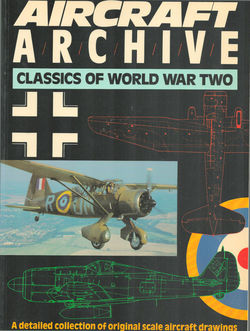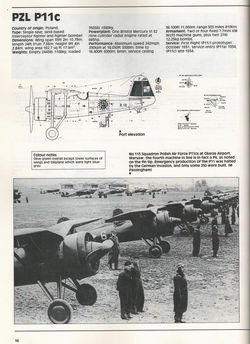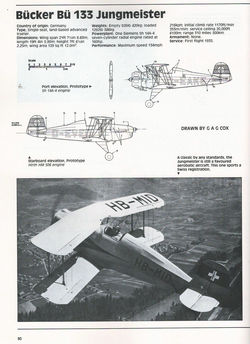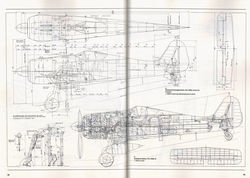AIRCRAFT
ARCHIVE CLASSICS OF WW2 USAAF USN USMC RAF LUFTWAFFE ITALY RUSSIA FRANCE CANADA
AN ARGUS SOFTBOUND BOOK in ENGLISH
POLIKARPOV Po-2 - The Polikarpov
Po-2 (also U-2, for its initial uchebnyy, 'training', role as a flight
instruction aircraft) served as an all-weather multirole Soviet biplane,
nicknamed Kukuruznik (Russian: Кукурузник, NATO reporting name
"Mule"). The reliable, uncomplicated design of the Po-2 design made
it an ideal trainer aircraft, as well as doubling as a low-cost ground attack,
aerial reconnaissance, psychological warfare and liaison aircraft during war,
proving to be one of the most versatile light combat types to be built in the
Soviet Union. As of 1978 it remained in production for a longer period of time
than any other Soviet-era aircraft. Production figures for Polikarpov U-2 and
Po-2 bombers and trainers combined are between 20,000 and 30,000 with
production ending as early as 1952.[2] Precise figures are hard to obtain since
low-rate production by small repair shops and air clubs likely continued until
1959.
DE HAVILLAND DH82A TIGER MOTH - The
de Havilland DH.82 Tiger Moth is a 1930s British biplane designed by Geoffrey
de Havilland and built by the de Havilland Aircraft Company. It was operated by
the Royal Air Force (RAF) and other operators as a primary trainer aircraft. In
addition to the type's principal use for ab initio training, the Second World
War had RAF Tiger Moths operating in other capacities, including maritime
surveillance and defensive anti-invasion preparations; some aircraft were even
outfitted to function as armed light bombers.
The Tiger Moth remained in service with the RAF until it was replaced by
the de Havilland Chipmunk during the early 1950s. Many of the military surplus
aircraft subsequently entered into civilian operation. Many nations have used
the Tiger Moth in both military and civilian applications, and it remains in
widespread use as a recreational aircraft. It is still occasionally used as a
primary training aircraft, particularly for those pilots wanting to gain
experience before moving on to other tailwheel aircraft. Many Tiger Moths are
now employed by companies offering trial lesson experiences. The de Havilland
Moth club, founded in 1975, is now an owners' association offering a mutual
club and technical support.
PZL P11c - The P.11c would be the
principal (and final) variant of the type to be inducted into the Polish Air
Force. First reaching fighter squadrons during late 1935, it featured the
adoption of a new, refined fuselage, a major change of which being the
relocation of the engine to be 13 cm lower down in the aircraft's nose, which
had the advantage of providing the pilot with an improved exterior view.
Besides, a new stronger engine Mercury V S2 had smaller diameter. Forward
framework was longer, covering an enlarged and more comfortable cockpit, with
pilot's seat moved 30 cm rearwards and raised by 5 cm. The central part of the
wings was also modified. During 1934, production of the P.11c commenced, by
1936, the type was being produced at a rate of 25 fighters per month; in total,
150 aircraft were produced by the end of production in 1936 (older sources
quoted a number of 175, which is not confirmed in any documents). The first
series of approximately 50 P.11c aircraft were fitted with Mercury V S2 of 600
hp (447 kW), the rest with Mercury VI S2 of 630 hp (470 kW).
HEINKEL He51B-1 - The Heinkel He 51
was a German single-seat biplane fighter aircraft. A seaplane variant and a
ground-attack version were also developed.
The He 51 was intended to replace the earlier Arado Ar 65, and served
side-by-side with the slightly later Arado Ar 68. The He 51 was obsolete before
it even entered service, and after an initial run of 150 production fighters, production
switched to the modified He 51B, of which approximately 450 were built
FOCKE-WULF Fw56 STOSSER (FALCON) - The
Fw 56 was developed, in accordance with a request by the Reich Air Ministry for
an advanced fighter trainer, by Kurt Tank, chief engineer with Focke-Wulf. It
was also considered for possible use as a home defence fighter.
The first prototype flew for the
first time in November 1933. A second prototype had some modifications made to
the fuselage, and metal rather than wooden wings for flight testing. The third
prototype, which flew in February 1934, reverted to the wooden wing and
satisfied the technical designers. After
comparison flights in 1935 against its two competitors - the Arado Ar 76 and
the Heinkel He 74 - the Air Ministry ordered production to begin. About 1,000
aircraft were built, mostly used by Germany, though numbers were used by
Austria and Hungary. A few were sold for private use, for instance to Gerd
Achgelis, who later founded the helicopter company Focke-Achgelis with Henrich
Focke. Ernst Udet, an advocate of the
use of dive bombers, demonstrated[1] the second prototype - Fw 56 V2 - in this
role, leading to Luftwaffe development of dive bombers.
POLIKARPOV I-16 RATA - The
Polikarpov I-16 (Russian: Поликарпов И-16) is a Soviet single-engine
single-seat fighter aircraft of revolutionary design; it was the world's first
low-wing cantilever monoplane fighter with retractable landing gear to attain
operational status and as such "introduced a new vogue in fighter
design". The I-16 was introduced in the mid-1930s and formed the backbone
of the Soviet Air Force at the beginning of World War II. The diminutive
fighter, nicknamed "Ishak" or "Ishachok"
("donkey" or "burro") by Soviet pilots, figured prominently
in the Second Sino-Japanese War, the Battle of Khalkhin Gol, Winter War and the
Spanish Civil War – where it was called the Rata ("rat") by the
Nationalists or Mosca ("fly") by the Republicans. The Finns called
the aircraft as Siipiorava "(flying squirrel)".
BUCKER Bu133 JUNGMEISTER - The
Bücker Bü 133 Jungmeister was an advanced trainer of the Luftwaffe in the
1930s. It was a single-engine, single-seat biplane of wood and tubular steel
construction and covered in fabric. The
aircraft showed "astonishing agility" at its first public appearance,
the 1936 International Aerobatic Championship at Rangsdorf, but the Bü 133A
garnered no orders; only two Bü 133Bs, with 160 hp (119 kW) Siemens-Halske
Sh.14A-4 radial engines, were built. The main production type was the 160 hp
(119 kW) Siemens-Bramo Sh 14A radial powered Bü 133C, which had a distinctive
cowling and a 13 cm (5.1 in)-shorter fuselage, and the same fine aerobatic
performance as the Bü 133A. Fifty-two were manufactured under licence by
Dornier Flugzeugwerke for the Swiss Air Force (which kept it in service until
1968).[1] Twenty five Jungmeisters, initially powered by Hirth HM506 engines,
were licence-built for the Spanish Air Force from 1940–42 by CASA with the
designation CASA 1-133L, although they were later re-engined with Sh 14
engines. They joined the survivors of 22 German-built Bü-133Cs in Spanish
service
CURTISS SBC-3 AND SBC-4 HELLDIVER US
NAVY - The Curtiss SBC Helldiver was a two-seat scout bomber and dive bomber
built by the Curtiss-Wright Corporation. It was the last military biplane
procured by the United States Navy. Delivered in 1937, it became obsolete even
before World War II and was kept well away from combat with Axis fighters.
FIESELER Fi156C STORCH VTOL LIASION
AIRCRAFT WW2 GERMAN LUFTWAFF - The Fieseler Fi 156 Storch ("stork")
was a German liaison aircraft built by Fieseler before and during World War II.
Production continued in other countries into the 1950s for the private market.
It was notable for its excellent short field (STOL) performance and low
stalling speed of 50 km/h (31 mph). French-built later variants often appear at
air shows. Compared to most other liaison aircraft of the period, the Storch
was quite large and heavy, with its wingspan exceeding 14 meters (nearly 47
feet) and its weight slightly over 1,300 kg (2,900 pounds) when fully loaded.
It was significantly heavier, slower, and less agile than Allied liaison
aircraft such as the American Piper L-4 or Stinson L-5, or the British Auster.
BOEING STEARMAN PT-12 / PT-18 KAYDET
PRIMARY TRAINER USAAC USAAF - The Stearman (Boeing) Model 75 is a biplane formerly
used as a military trainer aircraft, of which at least 10,626 were built in the
United States during the 1930s and 1940s. Stearman Aircraft became a subsidiary
of Boeing in 1934. Widely known as the Stearman, Boeing Stearman, or Kaydet, it
served as a primary trainer for the United States Army Air Forces, the United
States Navy (as the NS and N2S), and with the Royal Canadian Air Force as the
Kaydet throughout World War II. After the conflict was over, thousands of
surplus aircraft were sold on the civilian market. In the immediate postwar
years, they became popular as crop dusters and sports planes, and for aerobatic
and wing walking use in air shows.
WESTLAND LYSANDER WW2 RAF ARMY
COOPERATION AIRCRAFT SOE - The Westland Lysander is a British army co-operation
and liaison aircraft produced by Westland Aircraft that was used immediately
before and during the Second World War. After
becoming obsolete in the army co-operation role, the aircraft's short-field
performance enabled clandestine missions using small, improvised airstrips
behind enemy lines to place or recover agents, particularly in occupied France
with the help of the French Resistance. Royal Air Force army co-operation
aircraft were named after mythical or historical military leaders; in this case
the Spartan admiral Lysander was chosen.
PIPER J-3 CUB US ARMY LIASION
AIRCRAFT - The Piper J-3 Cub is an American light aircraft that was built
between 1938 and 1947 by Piper Aircraft. The aircraft has a simple, lightweight
design which gives it good low-speed handling properties and short-field
performance. The Cub is Piper Aircraft's most-produced model, with nearly
20,000 built in the United States. Its simplicity, affordability and popularity
invokes comparisons to the Ford Model T automobile. The aircraft is a high-wing, strut-braced
monoplane with a large-area rectangular wing. It is most often powered by an
air-cooled, flat-4 piston engine driving a fixed-pitch propeller. Its fuselage
is a welded steel frame covered in fabric, seating two people in tandem. The Cub was designed as a trainer. It had
great popularity in this role and as a general aviation aircraft. Due to its
performance, it was well suited for a variety of military uses such as
reconnaissance, liaison and ground control. It was produced in large numbers
during World War II as the L-4 Grasshopper. Many Cubs are still flying today.
Cubs are highly prized as bush aircraft.
The aircraft's standard chrome yellow paint came to be known as
"Cub Yellow" or "Lock Haven Yellow".
MACCHI MC200 SAETTA WW2 ITALIAN AIR
FORCE REGIA AERONAUTICA - The Macchi C.200 Saetta (Italian:
"Lightning"), or MC.200, was a fighter aircraft developed and
manufactured by Aeronautica Macchi in Italy. Various versions were flown by the
Regia Aeronautica (Italian Air Force) who used the type throughout the Second
World War. The C.200 was designed by
Mario Castoldi, Macchi's lead designer, to serve as a modern monoplane fighter
aircraft, furnished with retractable landing gear and powered by a radial
engine. The C.200 possessed excellent maneuverability, and its general flying
characteristics left little to be desired. Its stability in a high-speed dive
was exceptional, but it was underpowered and underarmed in comparison to its
contemporaries. Early on, there were a number of crashes caused by stability
problems, nearly resulting in the grounding of the type; these problems were
ultimately addressed via aerodynamic modifications to the wing. From the time Italy entered the Second World
War on 10 June 1940, until the signing of the armistice of 8 September 1943,
the C. 200 flew more operational sorties than any other Italian aircraft. The
Saetta saw operational service in Greece, North Africa, Yugoslavia, across the
Mediterranean, and in the Soviet Union (where it obtained an excellent kill to
loss ratio of 88 to 15). The plane's very strong all-metal construction and
air-cooled engine made the aircraft ideal for conducting ground attack
missions; several units flew it as a fighter-bomber. Over 1,000 aircraft had
been constructed by the end of the war.
CANADIAN GREGOR FDB-1 - The Gregor
FDB-1 was a Canadian biplane fighter, designed in 1938 by Michael Gregor and
manufactured by Canadian Car and Foundry. Despite having some advanced design
features such as flush rivetted all-metal construction and a retractable
undercarriage, the final generation of biplane fighters was being supplanted by
monoplanes and the Gregor FDB-1 was obsolete before it flew. Despite the Royal
Canadian Air Force's desperation for modern fighters, the sole example remained
unsold and was eventually lost in a fire in 1945. The Gregor FDB-1's model
designation stood for Fighter Dive Bomber indicating its intended roles.
DOUGLAS SBD-3 SBD-5 USN VB USMC VMB DAUNTLESS
DIVE BOMBER - The Douglas SBD Dauntless is a World War II American naval scout
plane and dive bomber that was manufactured by Douglas Aircraft from 1940
through 1944. The SBD ("Scout Bomber Douglas") was the United States
Navy's main carrier-based scout/dive bomber from mid-1940 through mid-1944. The
SBD was also flown by the United States Marine Corps, both from land air bases
and aircraft carriers. The SBD is best remembered as the bomber that delivered
the fatal blows to the Japanese carriers at the Battle of Midway in June 1942.
The type earned its nickname "Slow But Deadly" (from its SBD
initials) during this period, along with a rarely-used accompanying nickname of
"Furious D." During its combat
service, the SBD proved to be an excellent naval scout plane and dive bomber.
It possessed long range, good handling characteristics, maneuverability, potent
bomb load, great diving characteristics from the perforated dive brakes, good
defensive armament, and ruggedness. One land-based variant of the SBD –
omitting the arrestor hook — was purpose-built for the U.S. Army Air Forces, as
the A-24 Banshee.
FOCKE-WULF Fw190A-5, Fe190A-9,
Fw190F AND Fw190G - The Focke-Wulf Fw 190, nicknamed Würger[b]
("Shrike") is a German single-seat, single-engine fighter aircraft
designed by Kurt Tank at Focke-Wulf in the late 1930s and widely used during
World War II. Along with its well-known counterpart, the Messerschmitt Bf 109,
the Fw 190 became the backbone of the Jagdwaffe (Fighter Force) of the
Luftwaffe. The twin-row BMW 801 radial engine that powered most operational
versions enabled the Fw 190 to lift larger loads than the Bf 109, allowing its
use as a day fighter, fighter-bomber, ground-attack aircraft and to a lesser degree,
night fighter.
The Fw 190A started flying
operationally over France in August 1941 and quickly proved superior in all but
turn radius to the Spitfire Mk. V, the main front-line fighter of the Royal Air
Force (RAF), particularly at low and medium altitudes.[4] The 190 maintained
superiority over Allied fighters until the introduction of the improved
Spitfire Mk. IX. In November/December 1942, the Fw 190 made its air combat
debut on the Eastern Front, finding much success in fighter wings and specialised
ground attack units (Schlachtgeschwader – Battle Wings or Strike Wings) from
October 1943. The Fw 190A series'
performance decreased at high altitudes (usually 6,000 m (20,000 ft) and
above), which reduced its effectiveness as a high-altitude interceptor. From
the Fw 190's inception, there had been ongoing efforts to address this with a
turbosupercharged BMW 801 in the B model, the much longer-nosed C model with
efforts to also turbocharge its chosen Daimler-Benz DB 603 inverted V12
powerplant, and the similarly long-nosed D model with the Junkers Jumo 213.
Problems with the turbocharger installations on the -B and -C subtypes meant
only the D model entered service in September 1944. These high-altitude
developments eventually led to the Focke-Wulf Ta 152, which was capable of
extreme speeds at medium to high altitudes (755 km/h (408 kn; 469 mph) at
13,500 m (44,300 ft)).[6] While these "long nose" 190 variants and
the Ta 152 derivative especially gave the Germans parity with Allied opponents,
they arrived too late to affect the outcome of the war. The Fw 190 was well-liked by its pilots. Some
of the Luftwaffe's most successful fighter aces claimed many of their kills
while flying it, including Otto Kittel, Walter Nowotny and Erich Rudorffer. The
Fw 190 had greater firepower than the Bf 109 and, at low to medium altitude,
superior manoeuvrability, in the opinion of German pilots who flew both
fighters. It was regarded as one of the best fighter planes of World War II
MARTIN-BAKER MB5 - The British Martin-Baker MB 5
was the ultimate development of a series of prototype fighter aircraft built
during the Second World War. Neither the MB 5 nor its predecessors ever entered
production, despite what test pilots described as excellent performance. Martin-Baker
Aircraft began the MB 5 as the second Martin-Baker MB 3 prototype, designed to
Air Ministry Specification F.18/39 for an agile, sturdy Royal Air Force
fighter, able to fly faster than 400 mph. After the first MB 3 crashed in 1942,
killing Val Baker, the second prototype was delayed. A modified MB 3 with a
Rolls-Royce Griffon engine, rather than the Napier Sabre of the MB 3, was
planned as the MB 4, but a full redesign was chosen instead. The redesigned
aircraft, designated MB 5, used wings similar to the MB 3, but had an entirely
new steel-tube fuselage. Power came from a Rolls-Royce Griffon 83 liquid-cooled
V-12 engine, producing 2,340 hp (1,745 kW) and driving two three-bladed
contra-rotating propellers. Armament was four 20 mm Hispano cannon, mounted in
the wings outboard of the widely spaced retractable undercarriage. A key
feature of the design was ease of manufacture and maintenance: much of the
structure was box-like, favouring straight lines and simple conformation.[4] It
was built under the same contract that covered the building of the MB 3.
FAIREY SEAFOX - The Fairey Seafox
was a 1930s British reconnaissance floatplane designed and built by Fairey for
the Fleet Air Arm. It was designed to be catapulted from the deck of a light
cruiser and served in the Second World War. Sixty-six were built, with two
finished without floats and used as landplanes.
The Fairey Seafox was built to satisfy Air Ministry Specification
S.11/32 for a two-seat spotter-reconnaissance floatplane. The first of two
prototypes appeared in 1936, first flying on 27 May 1936,[1] and the first of
the 64 production aircraft were delivered in 1937. The flights were organised
as 700 Naval Air Squadron of the Fleet Air Arm.
The fuselage was of all-metal monocoque construction, the wings being
covered with metal on the leading edge, otherwise fabric. It was powered by a
16-cylinder 395 hp (295 kW) air-cooled Napier Rapier H engine. It cruised at
106 mph (171 km/h), and had a range of 440 mi (710 km). The Seafox handled well
but it was criticised for being underpowered, engine cooling was poor and
landing speeds were higher than desired.
In 1939, a Seafox played a part in the Battle of the River Plate against
the German pocket battleship Admiral Graf Spee, by spotting for the naval
gunners. Seafoxes operated during the early part of the war from the cruisers
HMS Emerald, Neptune, Orion, Ajax, Arethusa and Penelope and the armed merchant
cruisers HMS Pretoria Castle, Asturias and Alcantara. They remained in service
until 1943.








